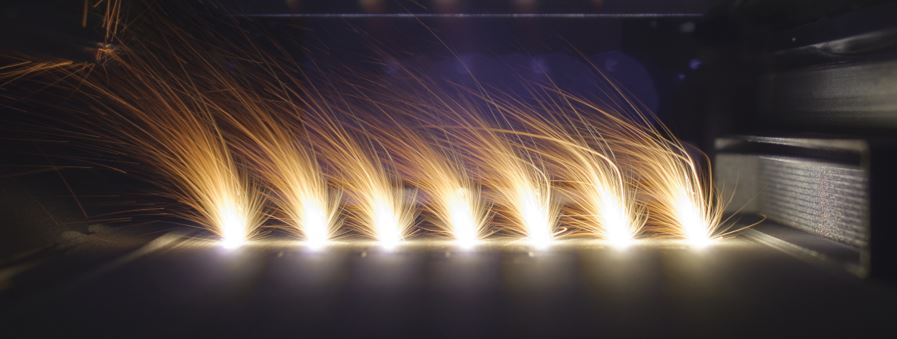![Long-term photo exposure of the LBM process [Image: Aconity]](https://fabbaloo.com/wp-content/uploads/2020/05/aconity1_img_5eb09bde1bbdb.jpg)
A recent partnership announcement shows how the business of 3D printing can be as fast-moving as the technology.
Recently, Aerosint and Aconity announced their partnership to advance multi-metal laser powder bed fusion (LPBF / SLS) 3D printing. The companies are a good fit for a number of reasons: tech and hardware, aligned applications focus, geography, flexibility. The last of these is perhaps too often underplayed in importance, but speaking with the players behind the partnership underscored the benefits of close contact and moving quickly.
Most of the time in discussing the technologies of Industry 4.0, we’re focusing on conversations on a digital workflow, localization, on-demand and on-site creation, global connection, and remote collaboration. We’re really more connected now than ever before, and it’s been a major factor in the growth of digital manufacturing.
But actual face time remains invaluable.
“The additive industry is still small, right,” Yves Hagedorn, CEO of Aconity, noted as we discussed the partnership. And some of that smallness is in regards to geography. “Aachen and Liège are not far away.”
Aconity’s base in Aachen, Germany is only about an hour away by train from Aerosint’s Liège, Belgium HQ, Aerosint Managing Director Edouard Moens de Hase noted.
“The geographical proximity is not something to take lightly. We are just one hour away from each other, this makes such integration projects much easier than working with another company that’s thousands of kilometers away from us, that’s another advantage I think,” he said.
Germany and Belgium both have very deep roots in additive manufacturing. Decades of experience have seen rapid developments in 3D printing emerge from this haven of industry. We see similar mapped groupings throughout the world, with Silicon Valley a major US focus for tech, for example.
Gaining access to other industry participants can lead to even tighter-knit communities — and build upon complementary expertise.
Both Aerosint and Aconity are also relatively young companies, Hagedorn continued. And both are built with collaborative focus in mind.
For Aconity, working directly with customers to create custom solutions is key.
“Our systems are open to apply process parameters the customers want to apply, and this is so also from the software and materials side,” Hagedorn said.
So, he noted, adding in Aerosint’s modular recoating to enable multi-metal 3D printing on the large AconityONE 3D printer is “very easy to implement.”
And the partnership isn’t focused on only these two participants. The teams are hoping to see more collaboration continue to build out the potential for multi-material metal 3D printing.
“This is both a pull and a push strategy,” Moens de Hase said. “We will push a new strategy into the market, and we pull by communicating with customers who mention ideas they have, and what they have been willing to do for many years but without adequate technology to do it. We hope a lot of potential users will reach out to us and can work on these topics with us.”
In this early stage of development, Hagedorn added, it’s especially vital to get more people involved. Feedback now can be directly integrated into the R&D going into the multi-metal project. The partners noted they are currently looking for initial customers to get the technology into an industrial application, to work and build upon customer requirements and materials.
Also playing significantly into this relationship is an important aspect: timing. Not only in comedy, but in industry, it’s all in the timing.
“I hope I speak here for you here too Edouard,” Hagedorn said, “when I say we both feel there is a need to do things quickly without complex collaboration agreements. We are both dreaming about a world where additive manufacturing is as multi-materials as possible. We both have the tools to accomplish this goal.”
Those “complex collaboration agreements” tend to pop up in larger enterprises. Some arrangements get held up in paperwork and politics, as each step needs to pass through levels of oversight and approval. While 3D printing itself is touted as an agile process, the business (and businesses) behind it can hold up actual advances.
The Aerosint team noticed the difference in their work with Aconity as compared to approaches with other hardware firms.
“Our strategies focus on who to partner with among machine manufacturers on different opportunities; we’ve been talking to most of them. We have relationships with most of them,” Moens de Hase said. “The discussion seemed to be easier to have with Aconity than with some of the others, where as Yves explained they require very complex collaboration agreements and all the details need to be talked through. With Aconity, we have more of a common sense approach, which is: Let’s try to integrate the technology in one of our machines, then jointly try to get results, print something, get some interest from the market, and from there see where to go. We like this approach, it’s faster, it’s less complex, it fits better with our culture of being a startup and a small company. This relationship we were able to pull together very fast.”
The smoothness with which these two companies came together to agree on this collaboration is an interesting illustration of reduced complexity in not only workflow, but in work.
Hagedorn summed up the advantage inherent in this approach quite succinctly:
“Time is essential in this vast, dynamic market, and we both have the tools available for that.”











